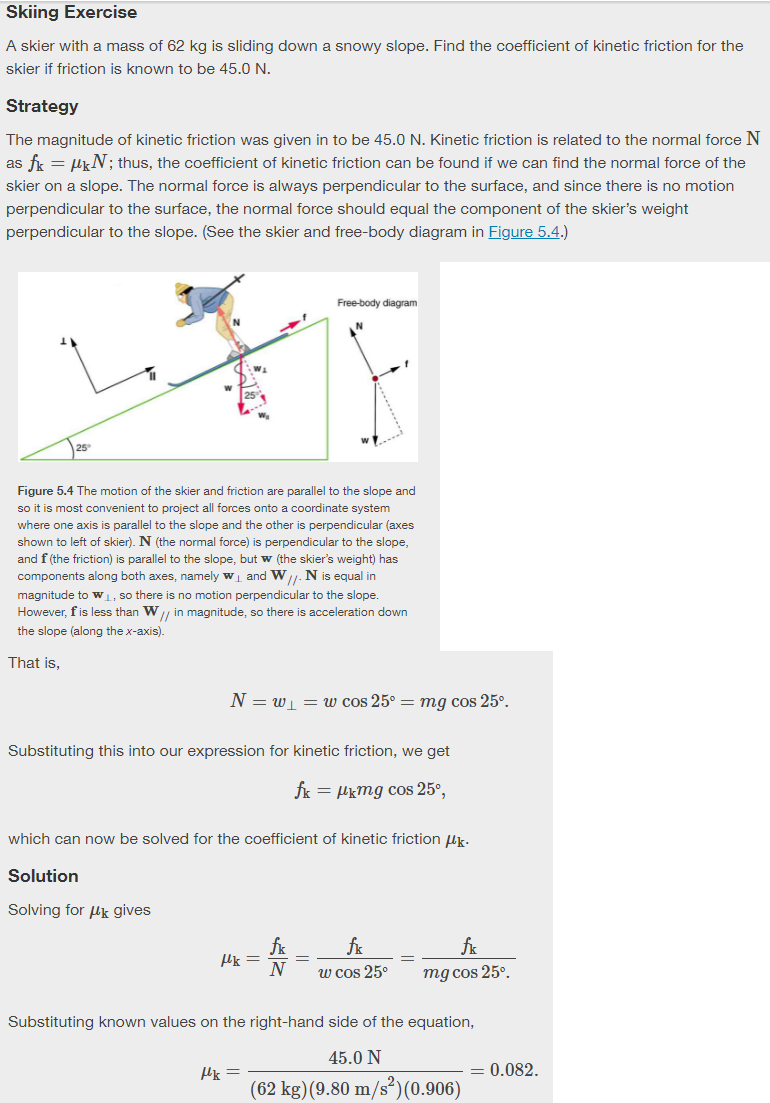3. In the OpenStax College Physics textbook, read the Chapter 5 section 5.1 (Friction). Then for Example 5.1 in that section, change the angle of the ski slope from 25 degrees to 30 degrees; also, change the skier's mass from "62 kg" to “Z kg" where Z is the number computed on the first page of this study guide. Then write the answer to the question in the space below. For your answer, remember to please write down your calculations and explain your reasoning. Draw a sketch if it'd be helpful, and please use your units correctly. If you are using any online resources (such as unit conversion tools) give their URL and webpage title in your answers. Z=49
3. In the OpenStax College Physics textbook, read the Chapter 5 section 5.1 (Friction). Then for Example 5.1 in that section, change the angle of the ski slope from 25 degrees to 30 degrees; also, change the skier's mass from "62 kg" to “Z kg" where Z is the number computed on the first page of this study guide. Then write the answer to the question in the space below. For your answer, remember to please write down your calculations and explain your reasoning. Draw a sketch if it'd be helpful, and please use your units correctly. If you are using any online resources (such as unit conversion tools) give their URL and webpage title in your answers. Z=49
Physics for Scientists and Engineers with Modern Physics
10th Edition
ISBN:9781337553292
Author:Raymond A. Serway, John W. Jewett
Publisher:Raymond A. Serway, John W. Jewett
Chapter6: Circular Motion And Other Applications Of Newton's Laws
Section: Chapter Questions
Problem 22P: Assume the resistive force acting on a speed skater is proportional to the square of the skaters...
Related questions
Topic Video
Question

Transcribed Image Text:3. In the OpenStax College Physics textbook, read the Chapter 5 section 5.1 (Friction). Then for
Example 5.1 in that section, change the angle of the ski slope from 25 degrees to 30 degrees; also,
change the skier's mass from “62 kg" to "Z kg" where Z is the number computed on the first page
of this study guide. Then write the answer to the question in the space below.
For your answer, remember to please write down your calculations and explain your reasoning.
Draw a sketch if it'd be helpful, and please use your units correctly. If you are using any online
resources (such as unit conversion tools) give their URL and webpage title in your answers.
Z=49

Transcribed Image Text:Skiing Exercise
A skier with a mass of 62 kg is sliding down a snowy slope. Find the coefficient of kinetic friction for the
skier if friction is known to be 45.0 N.
Strategy
The magnitude of kinetic friction was given in to be 45.0 N. Kinetic friction is related to the normal force N
as fk = HkN; thus, the coefficient of kinetic friction can be found if we can find the normal force of the
skier on a slope. The normal force is always perpendicular to the surface, and since there is no motion
perpendicular to the surface, the normal force should equal the component of the skier's weight
perpendicular to the slope. (See the skier and free-body diagram in Figure 5.4.)
Free-body diagram
Figure 5.4 The motion of the skier and friction are parallel to the slope and
so it is most convenient to project all forces onto a coordinate system
where one axis is parallel to the slope and the other is perpendicular (axes
shown to left of skier). N (the normal force) is perpendicular to the slope,
and f (the friction) is parallel to the slope, but w (the skier's weight) has
components along both axes, namely w and W. N is equal in
magnitude to w1, so there is no motion perpendicular to the slope.
However, fis less than W/ in magnitude, so there is acceleration down
the slope (along the x-axis).
That is.
N = w = w cos 25° = mg cos 25°.
Substituting this into our expression for kinetic friction, we get
fk = Hkmg cos 25°,
which can now be solved for the coefficient of kinetic friction lk.
Solution
Solving for uk gives
fik
Uk =
N
fk
w cos 25°
mg cos 25°.
Substituting known values on the right-hand side of the equation,
45.0 N
Hk =
= 0.082.
(62 kg)(9.80 m/s²)(0.906)
Expert Solution
This question has been solved!
Explore an expertly crafted, step-by-step solution for a thorough understanding of key concepts.
This is a popular solution!
Trending now
This is a popular solution!
Step by step
Solved in 2 steps with 1 images

Knowledge Booster
Learn more about
Need a deep-dive on the concept behind this application? Look no further. Learn more about this topic, physics and related others by exploring similar questions and additional content below.Recommended textbooks for you

Physics for Scientists and Engineers with Modern …
Physics
ISBN:
9781337553292
Author:
Raymond A. Serway, John W. Jewett
Publisher:
Cengage Learning

Physics for Scientists and Engineers
Physics
ISBN:
9781337553278
Author:
Raymond A. Serway, John W. Jewett
Publisher:
Cengage Learning

Principles of Physics: A Calculus-Based Text
Physics
ISBN:
9781133104261
Author:
Raymond A. Serway, John W. Jewett
Publisher:
Cengage Learning

Physics for Scientists and Engineers with Modern …
Physics
ISBN:
9781337553292
Author:
Raymond A. Serway, John W. Jewett
Publisher:
Cengage Learning

Physics for Scientists and Engineers
Physics
ISBN:
9781337553278
Author:
Raymond A. Serway, John W. Jewett
Publisher:
Cengage Learning

Principles of Physics: A Calculus-Based Text
Physics
ISBN:
9781133104261
Author:
Raymond A. Serway, John W. Jewett
Publisher:
Cengage Learning

College Physics
Physics
ISBN:
9781938168000
Author:
Paul Peter Urone, Roger Hinrichs
Publisher:
OpenStax College

Physics for Scientists and Engineers: Foundations…
Physics
ISBN:
9781133939146
Author:
Katz, Debora M.
Publisher:
Cengage Learning
